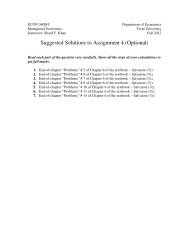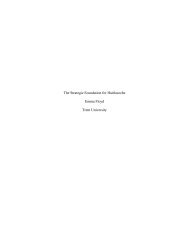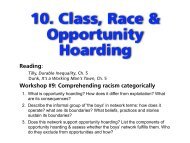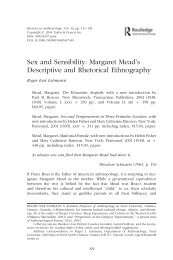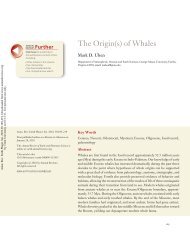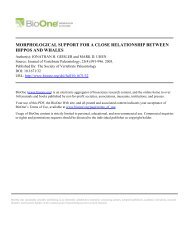REO FORTUNE'S PSYCHOLOGICAL THEORY OF CULTURAL ...
REO FORTUNE'S PSYCHOLOGICAL THEORY OF CULTURAL ...
REO FORTUNE'S PSYCHOLOGICAL THEORY OF CULTURAL ...
You also want an ePaper? Increase the reach of your titles
YUMPU automatically turns print PDFs into web optimized ePapers that Google loves.
Fortune’s Theory of Cultural Ambivalence<br />
277<br />
Third, in “substitution,” two layers of symbolism hide the repressed<br />
attitude. In one of Fortune’s examples, he dreamed of flowers (the censored<br />
version or manifest content), which, through punning association and<br />
common colors, he interpreted upon waking to represent the national flag<br />
(the surrogate), which in turn, represented extreme patriotism (the submergent).<br />
In substitution, the highly repressed submergent and the less<br />
repressed surrogate both remain out of the dream’s manifest content.<br />
Dream characters or things are substituted for repressed others based on<br />
punning or other similarities, and the disguise is so thorough that these<br />
dreams do not evoke much emotion. Substitution occurs when the attitude<br />
dreamt is highly repressed and censorship maintains control (Fortune 1927:<br />
64–65). When this happens there is “displacement”: “the image of the<br />
manifest content that has the greatest importance in connection with the<br />
latent content appears relatively inconspicuously” (Fortune 1927, 57).<br />
“Displacement appears to occur when repression is so heavy as to keep<br />
both submergent and surrogate in latent content” (Fortune 1927, 66).<br />
With his interest in the censorship of unacceptable attitudes, and interpreting<br />
dreams to find definite meanings, Fortune may initially appear to<br />
be a Freudian. However, Fortune countered Freud’s view that the censor,<br />
all-powerful in waking life, is weakened when we are asleep. Rather, he<br />
held that the censor continues to operate in sleep, but repressed material<br />
can slip past it into awareness because dreaming represents “a new mode<br />
of associative thinking, whereby objects are connected, not by the logical<br />
relations of contiguity or cognitive similarity that obtain in waking thought,<br />
but rather by similarity of affect” (1927, 15).<br />
While it now seems unwarranted to claim that dreams are unique in this<br />
way, the linking of ideas through affective similarity is certainly prevalent<br />
in dreaming. Fortune and Rivers both accepted Freud’s distinction between<br />
manifest and latent content; but both rejected Freud’s wish fulfillment<br />
theory of dreaming on the grounds that nightmares do not depict events<br />
that we want to occur (Fortune 1927: 16–17). According to Fortune, however,<br />
Rivers did “not accept the theory of the symbolic evasion of the censorship<br />
in dreams. Rivers believe[d] that the confused imagery of dreams<br />
may be explained as regression to a lower more infantile level of thinking”<br />
(Fortune 1927, 19). By contrast, Fortune argued that waking thought organizes<br />
emotions around objects, while dreaming thought organizes objects<br />
around emotions. Censorship is “the return of waking consciousness upon<br />
a type of thought which actively resists such a return” (Fortune 1927, 31).<br />
Since Fortune considered affective connection the basis of dream sce -<br />
narios, it followed that when censorship was strong, there was little manifest<br />
affect; when censorship was weak, affect was high (1927, 72).<br />
pacs-32-02-06.indd 277 9/7/2009 2:32:33 PM



